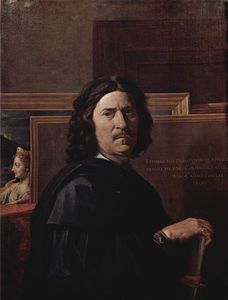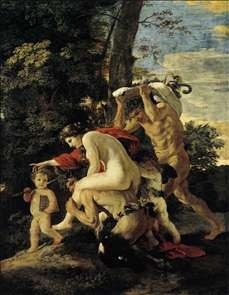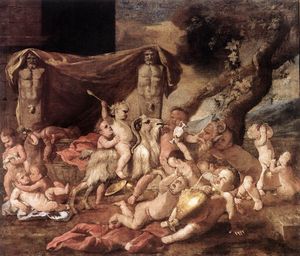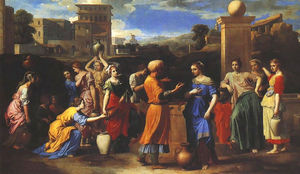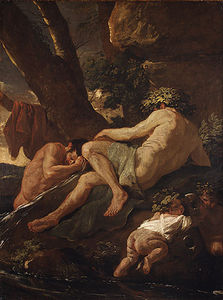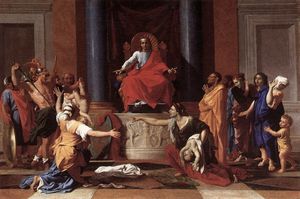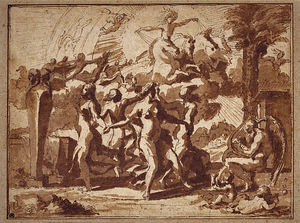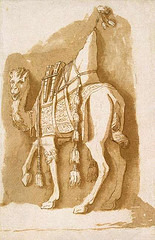Nicolas Poussin Style and Technique
- Full Name:
- Nicolas Poussin
- Short Name:
- Poussin
- Date of Birth:
- 15 Jun 1594
- Date of Death:
- 19 Nov 1665
- Focus:
- Paintings, Drawings
- Mediums:
- Oil, Other
- Subjects:
- Figure, Landscapes, Scenery
- Art Movement:
- Baroque
- Hometown:
- Les Andelys, France
- Nicolas Poussin Style and Technique Page's Content
- Introduction
- Style
- Method
Introduction
Nicolas Poussin's style is utterly distinct in Baroque art. Unlike the vibrant vivacity of Rubens, the gut-wrenching drama of Caravaggio, or the stunning realism of Velázquez, Poussin's style is cool, cerebral, intellectual and detached. Perhaps more than any other artist of the Baroque, Poussin obsessively theorized about his art, painstakingly planning every detail of his composition in order to create maximum impact. The result may seem stiff and dry to the contemporary viewer, but the fact remains that Poussin's style was enormously influential for the future of Western art.
Nicolas Poussin Style
Poussin's early style is characterized by the following qualities;
Warm, sensual color:
In his early years, Poussin was enormously influenced by the Venetian Renaissance, especially painters like Titian. This influence is evident in the warm, sensual colors Poussin employs in his early period: observe the fleshy tones of pink, mauve, ocher and brown in the early Bacchanal of Putti, for example.
Poussin was taken with the Venetian Renaissance during his early travels to Italy in 1619 and 1622, but after moving to Rome Poussin became obsessed with the classicizing art of Raphael and antique art. These warm flesh-tones thus disappear from Poussin's palette in the 1630s.
Baroque dynamism:
Poussin's art may be far more classicizing but it is still imbued with a fundamentally Baroque energy and dynamism.
Strong contours:
From the very beginning of his career, Poussin's paintings were notable for the artist's emphasis on line and contours, which reveals Poussin's interest in draftsmanship as well as the stimulus of the antique.
Mature Style:
Being in Rome had a major impact on Poussin. This famous painter of the French Baroque wasn't just influenced by the omnipresent relics of antique art and architecture, but also by classical texts, philosophy, and literature, to which he was introduced by close friend and patron Cassiano del Pozzo.
Poussin's mature style is characterized by the following qualities;
Rhetorical gestures:
Poussin's mature paintings become increasingly theatrical. For this artist, the pose, gesture and facial expression of each and every figure was meaningful, and essential to the expression of the art work's overall meaning.
Poussin thus carefully studied the pose for each of his painted figures, using the appropriate "rhetorical gesture" as devised by the Classical orators. Such gestures may seem stiff, odd, or melodramatic to the contemporary viewer, but many of Poussin's contemporaries considered this style to be sheer genius.
Cooler colors:
Poussin's use of color was determined by two factors: first of all, the painter was convinced that color was essential for setting the mood of a painting, and second of all, as an ardent student of optics, he was most interested in color in terms of its relationship to light. From the 1630s onward, therefore, Poussin abandoned his earlier Venetian palette in favor of much colder colors which were carefully calculated to produce a specific effect, and which were tempered with a careful use of chiaroscuro.
Take Poussin's The Judgment of Solomon, for example; in this painting, the artist employed a discordant color harmony in order to convey the personage's feelings of rage, sorrow, and loss (note the terrible greenish tinge of the mother and baby on the right). In more joyous paintings, on the other hand, a more harmonious color scheme would be used.
Frieze-like composition:
Poussin's paintings are often compared to ancient sculptures and friezes, which Poussin carefully studied. Just like in those earlier examples, in his later period Poussin tends to group his figures in the foreground of the painting, with the space of the painting carefully defined and realistically receding.
The theory of the modes:
In 1647, Poussin developed a theory of art which held that every element of a painting (color, line, and form) had a powerful psychological impact on the viewer, and thus each of these elements must be exploited as such.
Poussin based this theory in part on classical music theory, and this concept was the theoretical backbone of all his mature art. In Poussin, nothing was left to chance: absolutely every aspect of his paintings was planned in advance with a particular emotional impact in mind. When once asked how he achieved such perfection in painting, Poussin replied, "I have neglected nothing."
Nicolas Poussin Method
Drawing techniques:
Poussin's working techniques were far different from those of his contemporaries. While other artists invested a great deal of time and energy into oil sketches and cartoons, letting their assistants take over much of the actual painting.
Poussin was totally different: the original control freak, he despised letting other artists help him with his work, and never had the giant factory-type workshops of other Baroque artists like Rubens or Ribera.
Furthermore, Poussin felt that the transferring of his design from the cartoon to the final painted image was also an essential part of the creative process, and one which he preferred to execute himself. Therefore, Poussin's preparatory drawings tend to be less finished than those of his contemporaries, and are utterly voluminous: the artist would sketch dozens of versions of the final theme, varying lighting, poses and composition.
Preparatory techniques:
In order to aid himself in the preparatory work as he was envisaging his future masterpiece, Poussin utilized a most unusual invention: a tiny theatre-set, or shadow box. Poussin would mold wax figures and place them in the box in front of a realistic background, like a stage set, and then, looking through the box, would make sketches.
In the first phase of this process, Poussin's little wax figures were in the nude, to aid the artist in his depiction of the human anatomy. Then, as he would vary the position of the figures, Poussin would replace the little nude figures with larger ones clad in tissue robes and cloaks. This working method most likely accounts in a large part for the stiff, theatrical figures in Poussin's paintings as well as the often box- or theatre-like space.

